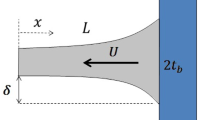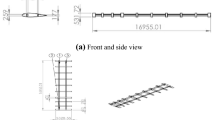Abstract
In this paper, the propulsion performance of a spanwise flexible oscillating wing, which is broadly similar to the undulation of a fin fluke, is investigated. The geometry of the fluke underwent three prescribed harmonic oscillating motions simultaneously while surging with constant velocity. The effect of deflection phase angle, flexibility parameter, and wing tip deflection amplitude on thrust coefficient and swimming efficiency was studied. A low-order unsteady panel method coupled with a time stepping algorithm for free wake alignment is implemented in a computer program to estimate the propulsion efficiency of lifting bodies. A novel approach is introduced to evaluate the singular integrals of line vortices by using an adaptive mollifier function. This method is an efficient way to accelerate computational speed by reducing the order of problem from R3 to body boundaries. Results present the significant effect of phase angle on the propulsion characteristics of oscillating fluke.
Similar content being viewed by others
References
Aono, H., Chimakurthi, S. K., Wu, P., Sällström, E., Stanford, B. K., Cesnik, C. E., Ifju, P., Ukeiley, L., and Shyy, W., 2010. A computational and experimental study of flexible flapping wing aerodynamics. 48th AIAA Aerospace Sciences Meeting Including the New Horizons Forum and Aerospace Exposition. Orlando, Florida, AIAA-2010–554.
Bose, N., and Lien, J., 1989. Propulsion of a fin whale (Balaenoptera physalus): Why the fin whale is a fast swimmer. Proceedings of the Royal Society of London B: Biological Sciences, 237 (1287): 175–200.
Bose, N., Lien, J., and Ahia, J., 1990. Measurements of the bodies and flukes of several cetacean species. Proceedings of the Royal Society of London B: Biological Sciences, 242 (1305): 163–173.
Delhommeau, G., 1989. Amélioration des performances des codes de calcul de diffraction-radiation au premier ordre. Proceedings of the 2èmes Journées de l’Hydrodynamique. Nantes, Franc., 69–88.
Esfahani, J., Barati, E., and Karbasian, H. R., 2013. Effect of caudal on hydrodynamic performance of flapping foil in fishlike swimming. Applied Ocean Research, 42: 32–42.
Esfahani, J., Barati, E., and Karbasian, H. R., 2015a. Fluid structures of flapping airfoil with elliptical motion trajectory. Computers & Fluids, 108: 142–155.
Esfahani, J., Karbasian, H. R., and Barati, E., 2015b. Proposed kinematic model for fish-like swimming with two pitch motions. Ocean Engineering, 104: 319–328.
Fish, F. E., Legac, P., Williams, T. M., and Wei, T., 2014. Measurement of hydrodynamic force generation by swimming dolphins using bubble DPIV. Journal of Experimental Biology, 217 (2): 252–260.
Garrick, I. E., 1936. Propulsion of a flapping and oscillating airfoil. National Advisory Committee for Aeronautics, Report No. 56., 9pp.
Heathcote, S., Martin, D., and Gursul, I., 2004. Flexible flapping airfoil propulsion at zero free stream velocity. AIAA Journal, 42 (11): 2196–2204.
Heathcote, S., Wang, Z., and Gursul, I., 2008. Effect of spanwise flexibility on flapping wing propulsion. Journal of Fluids and Structures, 24 (2): 183–199.
Hess, J. L., 1972. Calculation of potential flow around arbitrary three dimensional lifting bodies. McDonnell Douglas Corporation, Report No. MDCJ 5679-01.
Hess, J. L., and Smith, A. M. O., 1962. Calculation of non-lifting potential flow about arbitrary 3D bodies. Douglas Aircraft Division, Report No. E.S. 40622, Californi., 177pp.
Hu, H., Kumar, A. G., Abate, G., and Albertani, R., 2010. An experimental investigation on the aerodynamic performances of flexible membrane wings in flapping flight. Aerospace Science and Technology, 14 (8): 575–586.
Kang, C.-K., Aono, H., Cesnik, C. E., and Shyy, W., 2011. Effects of flexibility on the aerodynamic performance of flapping wings. Journal of Fluid Mechanics, 689: 32–74.
Karbasian, H. R., and Esfahani, J., 2017. Enhancement of propulsive performance of flapping foil by fish-like motion pattern. Computers & Fluids, 156: 305–316.
Le, T. Q., Ko, J. H., Byun, D., Park, S. H., and Park, H. C., 2010. Effect of chord flexure on aerodynamic performance of a flapping wing. Journal of Bionic Engineering, 7 (1): 87–94.
Lee, J., 1987. A potential based panel method for the analysis of marine propellers in steady flow. PhD thesis. Massachusetts Institute of Technology.
Liu, P., 1996. A time-domain panel method for oscillating propulsors with both chordwise and spanwise flexibility. PhD thesis. Memorial University of Newfoundland.
Liu, P., and Bose, N., 1997. Propulsive performance from oscillating propulsors with spanwise flexibility. Proceedings of the Royal Society of London, 453: 1763–1770.
Morino, L., and Kuo, C.-C., 1974. Subsonic potential aerodynamics for complex configurations: A general theory. AIAA Journal, 12 (2): 191–197.
Najafi, S., and Abbaspour, M., 2017. Numerical study of propulsion performance in swimming fish using boundary element method. Journal of the Brazilian Society of Mechanical Sciences and Engineering, 39 (2): 443–455.
Politis, G. K., 2016. Unsteady wake rollup modeling using a mollifier based filtering technique. Development and Applications of Oceanic Engineering, 5: 1–28.
Pourmostafa, M., and Ghadimi, P., 2018. Investigating the interaction of two oscillating foils in tandem arrangement, using 3D unsteady boundary element method. Journal of the Brazilian Society of Mechanical Sciences and Engineering, 40 (9): 412.
Thaweewat, N., Phoemsapthawee, S., and Juntasaro, V., 2018. Semi-active flapping foil for marine propulsion. Ocean Engineering, 147: 556–564.
Young, J., 2005. Numerical simulation of the unsteady aerodynamics of flapping airfoils. PhD thesis. University of New South Wales.
Young, J., and Lai, J. C. S., 2004. Oscillation frequency and amplitude effects on the wake of a plunging airfoil. AIAA Journal, 42 (10): 2042–2052.
Zhan, J., Xu, B., Wu, J., and Wu, J., 2017. Power extraction performance of a semi-activated flapping foil in gusty flow. Journal of Bionic Engineering, 14 (1): 99–110.
Acknowledgement
The work described in this paper has been carried out during a research opportunity. I would like to thank the Iranian National Institute for Oceanography (INIO), Ocean Engineering and Technology Department for this opportunity they gave me.
Author information
Authors and Affiliations
Corresponding author
Rights and permissions
About this article
Cite this article
Najafi, S., Liu, P. Propulsion Performance of Spanwise Flexible Wing Using Unsteady Panel Method. J. Ocean Univ. China 19, 505–518 (2020). https://doi.org/10.1007/s11802-020-4214-x
Received:
Revised:
Accepted:
Published:
Issue Date:
DOI: https://doi.org/10.1007/s11802-020-4214-x




